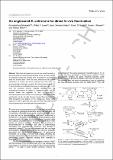Files in this item
An engineered E. coli strain for direct in vivo fluorination
Item metadata
| dc.contributor.author | Markakis, Konstantinos | |
| dc.contributor.author | Lowe, Phillip T. | |
| dc.contributor.author | Davison-Gates, Liam | |
| dc.contributor.author | O'Hagan, David | |
| dc.contributor.author | Rosser, Susan J. | |
| dc.contributor.author | Elfick, Alistair | |
| dc.date.accessioned | 2021-03-03T00:35:57Z | |
| dc.date.available | 2021-03-03T00:35:57Z | |
| dc.date.issued | 2020-03-03 | |
| dc.identifier | 266931333 | |
| dc.identifier | 293582e0-90a9-4365-9d4f-b421ca73ace1 | |
| dc.identifier | 85081569900 | |
| dc.identifier | 000517647500001 | |
| dc.identifier.citation | Markakis , K , Lowe , P T , Davison-Gates , L , O'Hagan , D , Rosser , S J & Elfick , A 2020 , ' An engineered E. coli strain for direct in vivo fluorination ' , ChemBioChem , vol. Early View . https://doi.org/10.1002/cbic.202000051 | en |
| dc.identifier.issn | 1439-4227 | |
| dc.identifier.other | RIS: urn:EDF0DD46A940C937344D0F6ACB17F17F | |
| dc.identifier.other | ORCID: /0000-0002-0510-5552/work/70919794 | |
| dc.identifier.other | ORCID: /0000-0003-1568-0750/work/122719951 | |
| dc.identifier.uri | https://hdl.handle.net/10023/21543 | |
| dc.description | This work was funded by the Industrial Biotechnology Innovation Centre (IBioIC) with support from GlaxoSmithKline, and also the EU Horizon 2020 (Sinfonia consortia). | en |
| dc.description.abstract | Selectively fluorinated compounds are found frequently in pharmaceutical and agrochemical products where currently 25–30 % of optimised compounds emerge from development containing at least one fluorine atom. There are many methods for the site‐specific introduction of fluorine, but all are chemical and they often use environmentally challenging reagents. Biochemical processes for C−F bond formation are attractive, but they are extremely rare. In this work, the fluorinase enzyme, originally identified from the actinomycete bacterium Streptomyces cattleya, is engineered into Escherichia coli in such a manner that the organism is able to produce 5′‐fluorodeoxyadenosine (5′‐FDA) from S‐adenosyl‐l‐methionine (SAM) and fluoride in live E. coli cells. Success required the introduction of a SAM transporter and deletion of the endogenous fluoride efflux capacity in order to generate an E. coli host that has the potential for future engineering of more elaborate fluorometabolites. | |
| dc.format.extent | 836676 | |
| dc.language.iso | eng | |
| dc.relation.ispartof | ChemBioChem | en |
| dc.subject | Escherichia coli | en |
| dc.subject | Fluoride channels | en |
| dc.subject | Fluorinases | en |
| dc.subject | Halogenations | en |
| dc.subject | SAM transporters | en |
| dc.subject | QD Chemistry | en |
| dc.subject | DAS | en |
| dc.subject.lcc | QD | en |
| dc.title | An engineered E. coli strain for direct in vivo fluorination | en |
| dc.type | Journal article | en |
| dc.contributor.sponsor | European Commission | en |
| dc.contributor.institution | University of St Andrews. School of Chemistry | en |
| dc.contributor.institution | University of St Andrews. Biomedical Sciences Research Complex | en |
| dc.contributor.institution | University of St Andrews. EaSTCHEM | en |
| dc.identifier.doi | https://doi.org/10.1002/cbic.202000051 | |
| dc.description.status | Peer reviewed | en |
| dc.date.embargoedUntil | 2021-03-03 | |
| dc.identifier.grantnumber | 814418 | en |
This item appears in the following Collection(s)
Items in the St Andrews Research Repository are protected by copyright, with all rights reserved, unless otherwise indicated.

